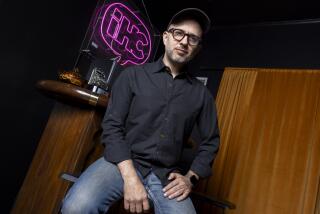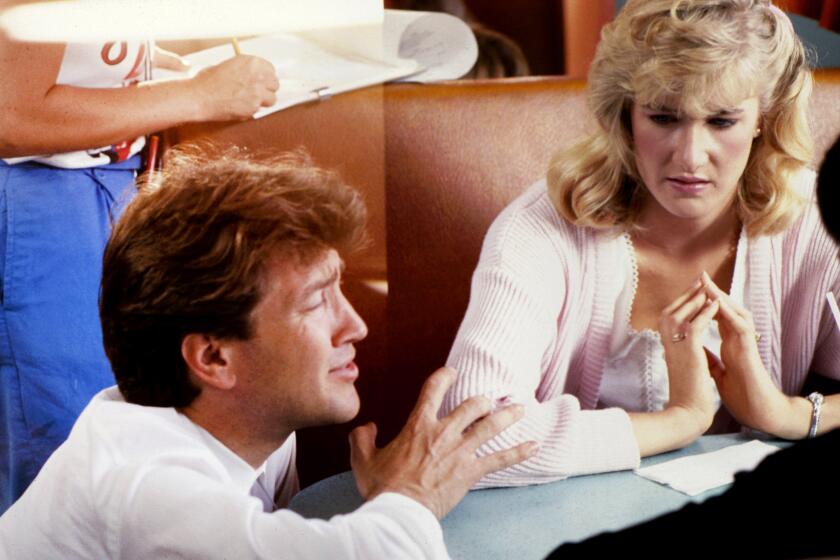Like Debut in 1935, the Pan’s Finale Was a Spectacle
- Share via
The Pan left this world the way it entered it--as a media event, and a good show to the last.
Fifty-four years and one week after the Pan opened to a blast of Boy Scout bugles, the twilight crowds in the Fairfax District strolled over on Wednesday evening to watch the old auditorium die in the whine of Fire Department sirens.
People walking dogs, young couples in a clinch, all stood watching. Film students, a good dozen at least, ran toward the flames, rolling tape, trailing wires, marveling at the spectacle. High-school-age Talmudic scholars from a Yeshiva school abandoned their books to watch, their black coats flapping as they ran down the street.
“People are tripping up and down the street,” said Joel Deutsch, 45, who lives a block away. “This is all spectating. There’s never any population out on the streets in this area this time of night. This is the most festive evening we can remember, actually.”
Much in the city shared the spectacle from where they were. By sunset, the vast smudges of smoke had spread out, obscuring the Hollywood Hills, and at the fire scene, spectators could only occasionally glimpse the four distinctive curved towers of the Pan’s apple-green facade. By 10:15 a.m., the last of them tipped over in a gush of flames and sparks, green and black smoke.
“It’s very sad,” said Sarah Housepeters, 45, who stood watching and holding her daughter Lily, 5. “It’s a remnant of history, part of a bit of Los Angeles gone. It’s a terrible loss.”
For much of her life, Nancy Heilbron, 61, has lived nearby. “It’s like losing a friend that you loved in a way, if you can love a building like a friend . . . it’s part of my life that’s gone.” She used the Pan to navigate by. “We’d say, ‘You know where Pan Pacific Auditorium is?’ . . . Now we’ll have to say CBS, I guess.”
It was fruitless for the Fire Department to warn people away; the flames drew them to the place--for some, for the first and last time.
David Logan, 25, and Brandi Machapo, 21, were both dressed in black, but only coincidentally. They had never even heard of the Pan, although they live nearby. Machapo, who works at a Melrose boutique, explained what brought them: “I like fire. The whole trauma thing. It’s neat, as long as it’s never at my house.”
As firefighters trailed long stretches of fire hose through Pan Pacific Park, which embraces the auditorium, the baseball and soccer games went on 200 yards from the fire, after the briefest of interruptions. The Yeshiva students returned to class. After-dinner joggers jogged on the running tracks. Up on Beverly, the usual line of diners waiting for hip Southwestern cuisine at the Authentic Cafe had something to entertain them as they waited outdoors; they stood watching the fire fight.
“The sky was a royal blue; all the black smoke going up,” said John Ewing, waiting for dinner with his wife and two children. “So spectacular.”
Robert DeRosa, 39, was more angry than sentimental: “It’s gotta be arson. It’s a political thing. It’s common knowledge that certain people in this city don’t want to renovate it.”
Psychic reader and adviser Dora Evans, whose shop is a block away, allowed that she had not foreseen the fire, but “I felt it was done accidentally by a crew of people . . . they didn’t mean for it to get so big.”
Before the towers had even fallen, Kathleen Rogers had organized Friends of the Pan Pacific Auditorium to force officials to rebuild. “We’ve just seen too much destruction of too many historic buildings in this area. It’s criminal what’s going on in this city. We’re just going to have a row of banks down Wilshire Boulevard and Beverly Boulevard.”
The Pan’s history, tarnished by brushes with demolition and years of neglect, began in May, 1935: Ten thousand people turned out for the auditorium’s debut, waiting behind a wire barricade for hours before a fanfare of Boy Scout bugles announced the grand moment had arrived. The first show to play the auditorium was a 16-day exposition honoring “the Great American Home.”
Journalists at the time described the new facility in breathless tones: “The auditorium, huge as it is, has an architectural dignity. . . . It is a permanent structure and will be used for future expositions and conventions.”
For 54 years, the permanence held.
RELATED STORY AND PICTURE: Part I, Page 1
More to Read
Only good movies
Get the Indie Focus newsletter, Mark Olsen's weekly guide to the world of cinema.
You may occasionally receive promotional content from the Los Angeles Times.











